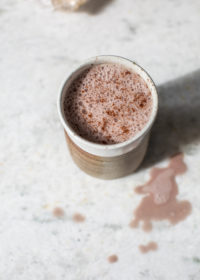Recipes: Tulsi Mint Tea

A few weeks ago, I was preparing to fly out to Sonoma to lead our last retreat of the summer. I found myself frantically rushing around to get ready. In between client sessions, errands, packing and planning, I also had to eat. So one afternoon, I jumped into the kitchen to start cooking. I was cutting the vegetables, rinsing the lentils, getting everything prepped to go on the eventual plate. If you’ve ever cooked, you know it’s a true practice in timing and multi-tasking. I added the ghee to skillet and turned the heat on high. Before I knew it, the ghee was popping and cracking but my veggies were not ready. A feeling immense anxiety and stress bubbled up inside me. As I peeled and chopped faster, “I have to get the vegetables in the pan now or the ghee will burn,” I kept thinking to myself. The intensity in my mind increased like the heat in pan. And then…a giant lightbulb went off over my head, I had the genius idea to simply turn the burner off. Duh.
It was the simplest, almost silly, realization. If I just turned down the heat, I’d be able to cook and actually enjoy the process without the stress. How many times had I cranked the heat too high in my life by overcommitting myself, putting my needs for spaciousness and ease on the back burner? Instead of managing my energy more efficiently, life would inevitably become more intense because I was rushing around to cram all the things in that was needed to meet those expectations I had placed on myself. Basically, turning the heat down on the skillet was a glaring metaphor for the ways I could make my life easier.
This intensity of pushing forward and doing more is a far too common affliction in our modern society, often leading to overwhelm, burnout and chronic fatigue. So if you’ve found yourself at this end-of-summer season feeling depleted after a period of cranking the heat up too high (don’t worry, it’s a normal experience this time of year!), here is a simple remedy to try. Take the intensity out of your thoughts and to-do’s, a simple shift in attitude can have a ripple effect. Take ten minutes to unplug from the phone, go put your feet in the grass, close your eyes and take five deep, slow breaths. Connect with your senses, feeling the sun on the skin, hearing the wind in the trees, smelling the changes of season in the crisper air, observing what tastes arise in the mouth, and then as you open your eyes, seeing the colors around you. By connecting with the senses and slowing the breath, we step into the possibility of presence. Then we see the illusion of the hustle we’ve bought into into a little more clearly.
I’m pairing this refreshing, immune-boosting tulsi tea recipe with my “Ah-Hah!” moment to help you take life from a boil to a low simmer – body and, in turn, mind. Tulsi, or Holy Basil, is a plant commonly used in Ayurvedic herbalism. It translates to “the incomparable one” and represents the goddess Lakshmi. The plant has deep mythological history, and in India, you’ll often find a pot of it near the home altar! Tulsi has many wonderful benefits which you can read more on here.

TULSI MINT TEA
2 tbsp dried tulsi leaves
2 tbsp dried mint leaves
6 cups water
1 lime, juiced
1-2 teaspoon organic, unprocessed cane sugar or coconut sugar
In a small pot, bring 6 cups of water to a low simmer. Turn off heat and add the tulsi and mint leaves. Cover with a lid and allow to steep for 20 minutes. Strain the liquid through a fine mesh strainer into a pitcher or large jar. Compost the pulp. Stir in the lime juice and sugar, if sweetening. Place in the fridge to chill. Sip cool but not icy!
Makes 4 servings
 [wpmenucart]
[wpmenucart] Recipe: Cooling Coriander, Basil & Lime Drink
Recipe: Cooling Coriander, Basil & Lime Drink  Recipes: Tahini Hot Chocolate
Recipes: Tahini Hot Chocolate  Recipes: Mulled Rose & Cranberry Pear Cider
Recipes: Mulled Rose & Cranberry Pear Cider 
I wil try! Thank you